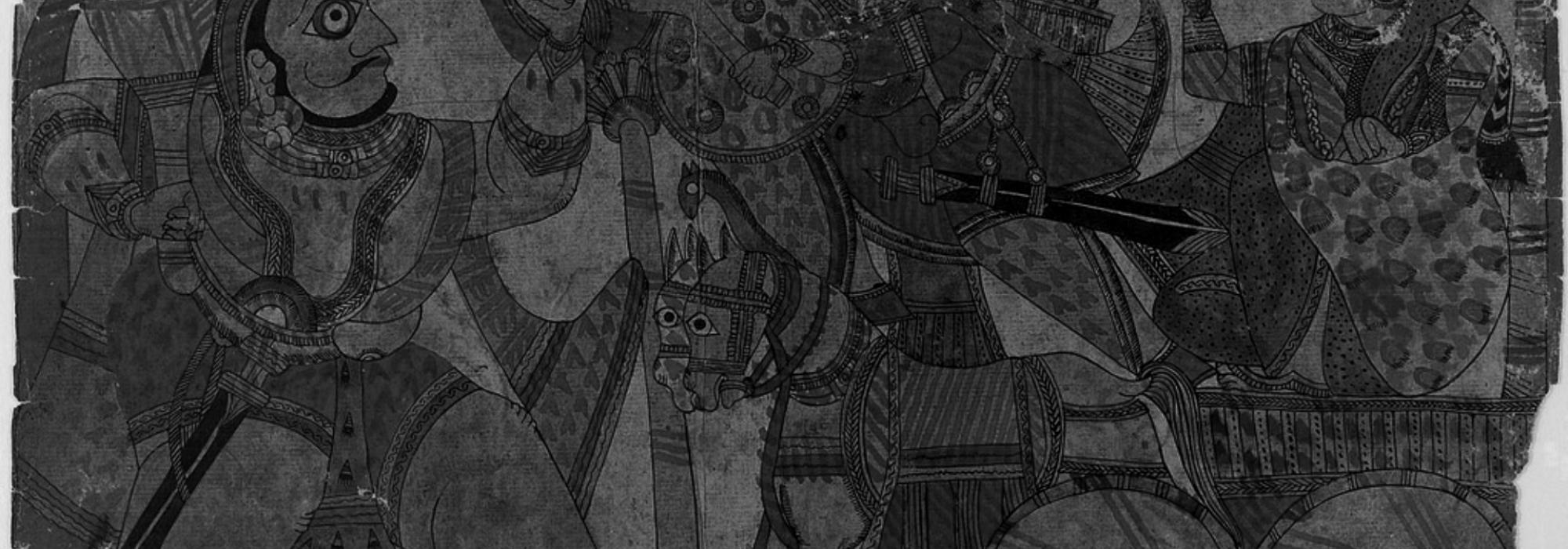The Mahabharata was also known as Jaya (victory). By using the word ‘जय,’ Vedavyasa speaks of kshaatra and valor. There, both dharma and adharma are permanent, pre-eminent. When Vyasa calls Duryodhana as “दुर्योधनो मन्युमयो महाद्रुमः” and Yudhishthira as “युधिष्ठिरो धर्ममयो महाद्रुमः” (MB 1.1.65-66), the implied meaning is ‘a kshatriya should be established in dharma and should gently nurture the world like a great tree.’
According to the Mimamsa school of Indian philosophy, the critical study of any work should entail an examination considering six features, known as षड्लिङ्ग – उपक्रम-उपसंहार (beginning and end; coherence of the work), अपूर्वत (newness, originality), अभ्यास (repetition and reinforcement of prominent themes), फल (results of one’s action), अर्थवाद (praise, eulogy), and उपपत्ति (evidence). When we examine the Mahabharata using these pointers, we find that in every aspect there is the spirit of kshaatra.
The Mahabharata starts with Janamejaya’s सर्प-यज्ञ (serpent ritual). During the सर्प-यज्ञ, the wicked ones were destroyed. But since it went overboard, crossing all limits, Astika came there. In the Mahabharata, at every step we find the dangers to the world when kshaatra falls. [Both pacifism and extreme aggression are against kshaatra. History shows us that both these tendencies give rise to a great deal of violence as opposed to kshaatra, which is interested in maintaining peace rather than blindly holding on to non-violence or blindly pursuing violence.] Shantanu's desire, Bhishma's oath, the birth of the Pandavas, the row between Drupada and Drona, the svayamvara of Draupadi, the killing of Jarasandha, the rajasuya yajna, the gograhana episode (see Bharavi’s Kiratarjuniyam), and the battle in Kurukshetra – in each of these instances, we find the importance of adhering to the spirit of kshaatra.
In the Udyoga Parva, the fearless Kunti even in her old age shows a rare spirit of kshaatra and courage. Krishna goes to Hastinapura to broker peace between the cousins and fails. The message that Kunti sends to her children through Krishna reserves a place in world literature as a piece of the finest heroic poetry. She recollects the story of Vidula, a brave mother whose son Sanjaya was a coward and escaped from the battlefield. Vidula drills sense into her son and sends him back to the battlefield. Kunti tells Krishna to remind her children this story. Finally Kunti says those unforgettable words,
यदर्थं क्षत्रिया सूते तस्य कालोऽयमागतः (MB 5.88.74)
“The reason for which a kshatriya woman bears children, the time has come for its fulfillment.”
This potent line has remained enshrined in people’s hearts as a reminder of the spirit of kshaatra.
The entire Udyoga Parva throbs with the kshaatra spirit; the following episodes are just an illustrative sample – before setting out to broker peace Krishna mocks and instigates Bhima; Draupadi’s rebukes the Pandavas in harsh words when they show their aversion to battling the Kauravas; Krishna promises Draupadi that her desire will be fulfilled and the battle shall be fought and won.
Further, on many occasions Yudhishthira’s lack of kshaatra has been countered by Bhima and Draupadi, Krishna and Kunti, showcasing the importance of the spirit of courage and heroism – we see this in Vana Parva (chapters 28, 29, 31, 34, 36), in Udyoga Parva (chapters 3, 29, 71, 73, 77, 80), and Shanti Parva (the first 38 chapters).
The Mahabharata relates stories of super-human (or divine) warfare between the devas and asuras, non-human (or animal) warfare between Garuda and the serpents, as well as human warfare between the Pandavas and Kauravas, thus intimately exploring the value and importance of the kshaatra tradition. It has brilliantly portrayed the life of courage and valor.
In the Bhagavad-Gita, what Krishna teaches is a lesson in kshaatra. The first words uttered by Krishna are:
कुतस्त्वा कश्मलमिदं
विषमे समुपस्थितम् |
अनार्यजुष्टमस्वर्ग्यम्
अकीर्तिकरमर्जुन ||
क्लैब्यं मा स्म गमः पार्थ
नैतत्त्वय्युपपद्यते |
क्षुद्रं हृदयदौर्बल्यं
त्यक्त्वोत्तिष्ठ परंतप ||
– भगवद्गीता २.२-३
[How can you lose heart in this hour of crisis? This is disgraceful, ignoble, and unworthy of higher realms. (BG 2.2)
Don’t be a coward, Arjuna; that’s not right for you! Arise, awake, and abandon your timidity, O destroyer of enemies! (BG 2.3)]
Krishna is expounding the value of kshaatra when he says “जहि शत्रुं” (BG 3.43), telling Arjuna, the master archer, to kill his enemies who have taken to the path of adharma. Accepting his advice, Arjuna finally says, “स्थितो’स्मि गतसंदेहः करिष्ये वचनं तव” (BG 18.73). When Sanjaya says in the end, “यत्र योगेश्वरः कृष्णो यत्र पार्थो धनुर्धरः” (BG 18.78), it underscores Arjuna’s bravery. [It is nothing but a reiteration of the braahma-kshaatra harmony.] From the Gita, which is the very core of the Mahabharata, to the rest of the epic, we find the value of braahma-driven kshaatra. And when the peace-loving Yudhishthira finally lands up on the battlefield, he fights without holding back, without hesitation. He didn’t need Krishna giving him battlefield advice. It wasn’t required for Bhima, Nakula, or Sahadeva too. We can see from this their undying adherence to their duty. In the later part of the Mahabharata, when Dhrtarashtra (before retiring to the forest) advises Yudhishthira, even in that we find nothing other than an emphasis on kshaatra and how it should protect dharma. We see this principle in all mahakavyas as well.
Translated from Kannada by Hari Ravikumar
(Translator’s notes in square brackets.)

















































